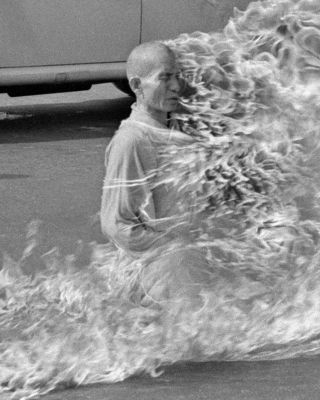
What does research on suicide by fire say about the death of Aaron Bushnell?
KEY POINTS
- Although the word “self-immolation” is used to mean suicide by fire, its etymology connotes “sacrifice.”
- In higher-income countries, suicide by fire is more likely among men with a history of mental illness.
- Self-immolation often reflects as much a desire to end one's life as a desire to protest a cause.
.jpg?itok=rAq3f4VN)
Self-immolation of Thích Qu?ng ??c
On February 25, 2024, US airman Aaron Bushnell set himself on fire in front of the Israeli embassy in Washington, DC, in an apparent act of opposition against the ongoing war in Israel and Gaza. Livestreaming the event on Twitch, he identified himself as a member of the US Air Force who was going to “engage in extreme act of protest” because he would “no longer be complicit in genocide,” referring to what was happening to Palestinians at the hands of “their colonizers.”1 He then doused himself in a flammable liquid and shouted “Free Palestine!” several times before igniting himself. He later died from his burn injuries.
In the days that followed, news reports emerged that characterized him as an “anarchist” and a former member of a “charismatic sect”2 as well as referencing unspecified evidence of “mental distress”1 leading up to his suicide.
Although a similar event received less media attention at the time, another protester of the Israel-Gaza War set herself on fire at the Israeli consulate in Atlanta back in December. She sustained critical burn injuries, but survived, with her actions later attributed to an “extreme political protest.”3
Without knowing more details, what can previous research on self-immolation tell us about why these individuals would engage in such behavior?
Protest by Fire
Although the word “self-immolation” is used to mean suicide by fire, its etymology connotes “sacrifice.”5 Indeed, self-immolation has been used as a form of protest through the act of suicide for thousands of years in both the East and the West including ancient Greece, 4th-century China, and 17th-century Russia.5 In 1963, the self-immolation of Thích Qu?ng ??c in protest of the US-supported South Vietnamese government’s persecution of Buddhists during the Vietnam War became one the most recognized acts of self-immolation ever, capturing the attention of a horrified President John F. Kennedy and prompting several copy-cat suicides in Vietnam and around the world including in the US. ??c’s act was immortalized in an iconic photo that was widely sold as a postcard and appeared on the cover of Rage Against the Machine’s debut album some 30 years later.
Over the past few decades, self-immolation has become more frequent and impactful than we might imagine. In 2001, several people set themselves on fire during protest in Tiananmen Square in Beijing. More than 160 Tibetans have set themselves ablaze since 2009 to bring attention to oppression by de facto Chinese rule.5 In 2010, Mohamed Bouazizi’s self-immolation helped to catalyze the Tunisian Revolution and the wider “Arab Spring” movement that followed. In 2016 and 2019, US military veterans Charles Richard Ingram III and John Watts died by self-immolation to protest the treatment they received through the Department of Veterans Affairs.6 In 2018, David Buckel died by setting himself on fire in Brooklyn’s Prospect Park in support of LGBTQ rights and climate change activism.
Self-Immolation and Mental Illness
As an act of protest that’s typically performed in a symbolic public setting, self-immolation often has a clear social purpose that includes attracting support to a cause and strengthening the resolve of a resistance group. Consequently, self-immolation has been called an “ultimate act of both despair and defiance, a symbol at once of resignation and heroic self-sacrifice.”4 Still, since it usually results in the death of the protestor, it should also be understood as a form of suicide.
This has led to the inevitable question of whether such apparent selfless sacrifice represents not only how important the plight of others is to an individual, but also how little their own life means to them in comparison. In other words, self-immolation may often be as much about sympathy and outrage as it is about self-loathing and self-deprecation, just as it might be as much a form of political protest as a desire for martyrdom, an attempt at redemption or symbolic cleansing, an end to personal suffering, or even a cry for help.6,7
Indeed, a 2011 study found a potentially high rate of mental illness among those who sustained injuries for self-inflicted burns that were not limited to acts of protest, with a wide range of 18 to 92 percent of samples.8 Within lower-income countries where there's a much greater rate of self-immolation compared to higher-income countries, self-immolators were more likely to be younger women without mental illness who were revolting against or seeking an escape from political and social oppression or domestic abuse.
Self-immolation is particularly common in the Middle East where as many as 70 percent of all suicides occur by self-immolation.8 A 2018 meta-analysis of studies published between 2000 and 2018 found 5717 cases of self-immolation in Iran with a mean age of 27 years including 70 percent who were women and only 20 percent with mental illness.9 A recent review of studies published between 2000 and 2022 found a similar female predominance among 4,486 self-immolators in Iraq. For such women, self-immolation is often both an act of political protest against oppression and a personal escape through suicide.
By contrast, self-immolation in higher-income countries is much less common and occurs more often among men with a history of mental illness (especially mood disorders), previous suicide attempts, and a precipitant in the form of financial difficulties or separation from a partner.8 A study of self-immolation in Greece revealed only 19 cases between 2011 and 2019 with an average age of 63 years including 60 percent who were men and 60 percent with a mental illness such as major depression or psychosis. A new study of 103 cases of self-immolation attributed to both suicide attempts and non-suicidal self-injury treated at the Arizona Burn Center between 2015 and 2022 similarly included 71 percent men and 83 percent who had a psychiatric illness.10 For the most part, these cases did not appear to represent acts of political protest.
#James Donaldson notes:
Welcome to the “next chapter” of my life… being a voice and an advocate for #mentalhealthawarenessandsuicideprevention, especially pertaining to our younger generation of students and student-athletes.
Getting men to speak up and reach out for help and assistance is one of my passions. Us men need to not suffer in silence or drown our sorrows in alcohol, hang out at bars and strip joints, or get involved with drug use.
Having gone through a recent bout of #depression and #suicidalthoughts myself, I realize now, that I can make a huge difference in the lives of so many by sharing my story, and by sharing various resources I come across as I work in this space. #http://bit.ly/JamesMentalHealthArticle
Find out more about the work I do on my 501c3 non-profit foundation
website www.yourgiftoflife.org Order your copy of James Donaldson's latest book,
#CelebratingYourGiftofLife: From The Verge of Suicide to a Life of Purpose and Joy

www.celebratingyourgiftoflife.com
Link for 40 Habits Signup
bit.ly/40HabitsofMentalHealth
If you'd like to follow and receive my daily blog in to your inbox, just click on it with Follow It. Here's the link https://follow.it/james-donaldson-s-standing-above-the-crowd-s-blog-a-view-from-above-on-things-that-make-the-world-go-round?action=followPub
Suicide by Any Other Name
So, what can these studies tell us about the mental health of Aaron Bushnell or his female counterpart who set herself on fire back in December to protest the Israel-Gaza War? Not much, really.
For one thing, published rates of mental illness have been quite variable (e.g., other studies have found much higher rates of mental disorder among Iranian women) and the reliability of such diagnoses in epidemiological studies is low in any case. Additionally, the presence or absence of a formally diagnosed mental illness doesn’t really say much about one’s mental health. One can have significant mental health issues including a wish to die without having a mental disorder. And whatever the rate of mental illness in a study sample, it doesn’t reliably predict anything at the level of an individual.
Still, research to date on self-immolation does invite speculation about why Bushnell might have been dissatisfied with merely protesting the war through political activism and felt the need to sacrifice himself for the cause. His reference to “complicity” suggests the possibility of guilt or moral injury related to his military service. With few close social ties (he'd previously described finding "social interactions very challenging"11) and writing a will, leaving his cat with a neighbor, and bequeathing a refrigerator full of root beer to a friend in the days leading up to his death,2 his self-immolation seems to have been as much a desire to stop the killing in Gaza as a desire to stop himself from living. As for why exactly, we may never know.
If you or someone you love is contemplating suicide, seek help immediately. For help 24/7 contact the National Suicide Prevention Lifeline, 1-800-273-TALK, or the Crisis Text Line by texting TALK to 741741. To find a therapist near you, see the Psychology Today Therapy Directory.

https://standingabovethecrowd.com/james-donaldson-on-mental-health-self-immolation-is-often-part-protest-part-suicide/


No comments:
Post a Comment